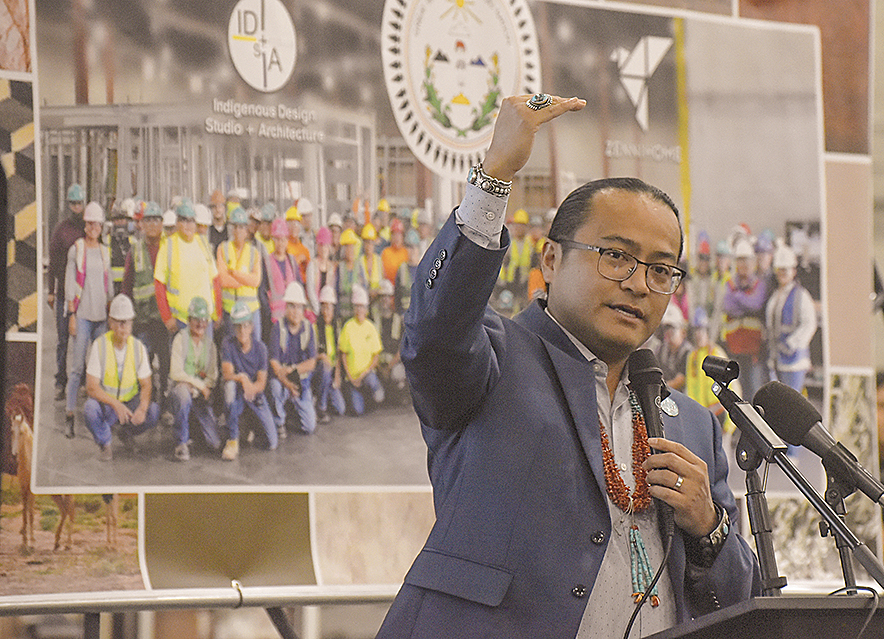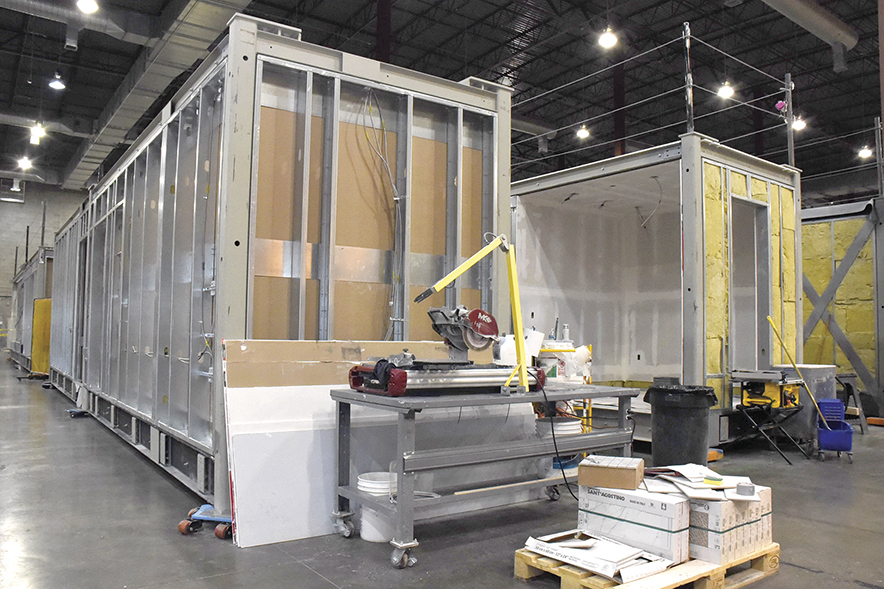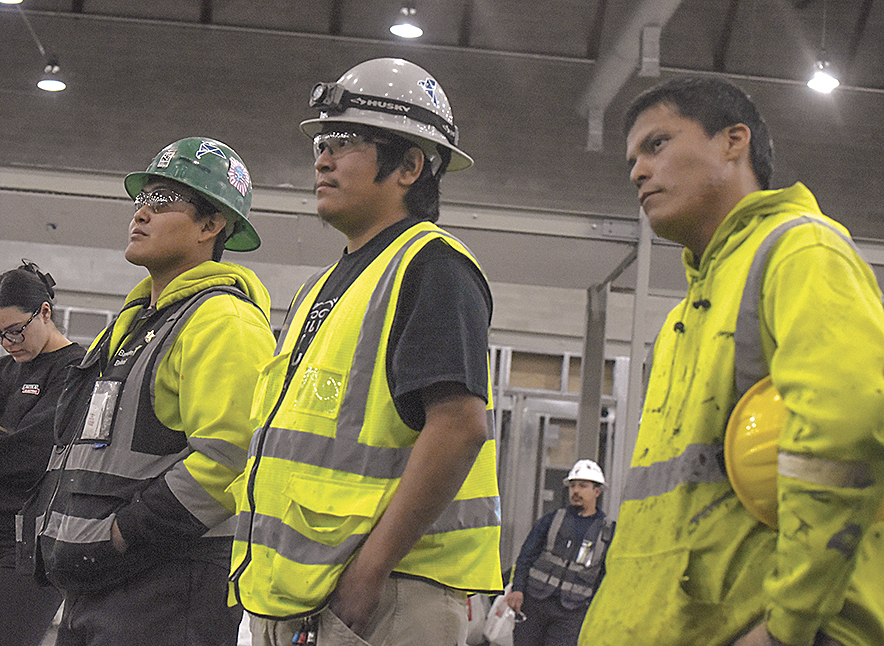
‘Navajo homes, Navajo built’: Nygren signs grant for ZenniHomes, IDS+A to expand production of manufactured homes

Navajo Times | Krista Allen
President Buu Nygren talks about partnering with ZenniHomes and IDS+A to build 200 manufactured homes. Nygren spoke during a grant-signing ceremony at the ZenniHome factory in LeChee, Ariz., on March 7, 2024.
ŁICHÍI’II, Ariz. – President Buu Nygren looked out over the homes in Diné Bikeyah en route to the ZenniHome factory at the decommissioned Navajo Generating Station site.
He left Tsébigháhoodzání around 5 a.m. last Thursday. “What if our homes were built as strong as the bricks some homes are built with––carefully put together by craftsmen?” he asked himself. “Nizhónígo.”

Navajo Times | Krista Allen
Incomplete ZenniHome units sit inside the ZenniHome factory in LeChee, Ariz., on March 7. The steel comes from the former Navajo Generating Station.
Contented with that vision, Nygren showed up at the ZenniHome factory in Łichíi’ii where 200 ZenniHome units would be built for families across the Navajo Nation. “Needy families” in each delegate region would receive ZenniHome units built from the steel recycled from the former power plant. The number of units for each region is not yet known, according to the president’s office as of Wednesday evening.
Bob Worsley, the ZenniHome CEO and founder, said 6,500 units could be built with the equivalent amount of steel taken from the power plant.
“That’s why I came here today,” Nygren said, t’áá Dinék’ehjígo. “These home (units) would be high-quality with structural integrity. They are the kind of homes our people (Diné) want and will put in place for the people.
“Grandfathers, grandmothers––children, will grow up and they’ll remember this,” Nygren added. “Indestructible homes are what I want for our people. This would be for the long haul––fifty, eighty years––it’ll last that long.”
The president visited the ZenniHome factory to spend time with the factory team about a year ago. It was then he told Worsley, “I want to do this with you, and I want these homes for my people.”
Nygren had made concrete promises to his supporters during his campaign: homes.
“And every day since he’s been in office,” Worsley said. “He wants to see 1,000 homes out on the Nation. And we want it to come from this facility as much as possible.”
Nygren last year launched a “1,000 Homes Initiative” to address the lack of housing in the Nation and the inability of young, educated Diné returning home to start a business.
Nygren on March 7 signed a $24 million ARPA grant with ZenniHome to expand production of its manufactured homes. The amount went up Thursday afternoon, according to George Hardeen, Nygren’s spokesman.
“We’re going to build homes by Navajo, on Navajo, for Navajo from this location that used to be a coal plant,” Worsley said. “We’re (ZenniHome team) are very excited about that.”
The ZenniHome factory is a 40,000 square-foot facility where at least three units can be built per day. Worsley wants to expand the factory by 300 square feet to build up to 30 units a day.
“We … want to start – immediately – building homes for the Navajo,” Worsley said. “We think this would be the first time the Navajo Nation has had a significant export business, which makes a sovereign nation even more a sovereign nation.”
The Division of Community Development received ARPA money under “numerous sections,” according to Arbin Mitchell, the executive director from Wide Ruins and Klagetoh, Arizona.
One section received $211 million for chapters and regions, which was divided into the 24 delegate regions. Each delegate region received $8.8 million for its projects. Another section received $150 million under contract for bathroom additions. One hundred bathroom additions have been built thus far.
The housing section received $50 million, according to Mitchell.
“Back in November, we did an RFQ, request for qualification, and 14 firms submitted their proposals,” he explained. “We started reviewing those proposals. Out of those 14, eight firms went to the next round. We interviewed the eight firms last week.

Navajo Times | Krista Allen
Diné men listen as President Buu Nygren speaks during a grant-signing ceremony at the ZenniHome factory in LeChee, Ariz., on March 7. Over 100 Diné workers are employed at ZenniHome.
“And within a couple weeks or so, we’re gonna select ZenniHome to do modular homes,” he added.
Worsley praised the ZenniHome team, a majority of which are Diné and are highly skilled welders, electricians, plumbers, among other trades. Its workforce grew from 85 Diné employees to 135, with an annual payroll of more than $8 million.
“When you need someone to work 24/7 and do fast, beautiful code-perfect welds––guess who we ask to come do it?” Worsley asked. “The Navajo. It’s always been the Navajo. We (at ZenniHome) think that building very strong steel structures that will last twice and three times longer than a (conventional) home.”
Worsley said it’s time for Diné families to live in upper-quality homes such as a ZenniHome unit.
“We’d really like to see that happen,” he said.
Nygren said because Worsley treats people with compassion, he wanted to work with him and ZenniHome.
The ARPA grant allows Indigenous Design Studio + Architecture, or IDS+A, a Diné-woman-owned architectural firm to expand production at ZenniHome.
“We want to be able to lay out your home,” said Tamarah Begay, the principal-in-charge of IDS+A. “This is important. (It’s) about connecting our culture, language, and traditions.”
Begay said construction costs in the Navajo Nation is “mind-boggling” after being in business for 12 years. It’s 30% to 40% higher in the Nation than in cities outside the Nation.
“We need to build homes that are affordable for our people,” Begay said. “Sustainable and durable that they’re not falling apart. This is IDS+A’s commitment: working with Zenni(Home) in the Navajo Nation, working together to provide these homes for our Navajo people and our Indigenous peoples across the nation.”
Mitchell said in Diné tradition, when one has a home, that’s stability.
“This is a step forward for the Navajo Nation,” he added. “Building homes here where NGS used to be. When NGS closed (in 2019), out went hundreds of jobs.
“This is another great venture Navajo will be moving forward with here. Like Bob (Worsley) said, ‘Navajo homes, Navajo built.’”








 Highway 264,
Highway 264, I-40, WB @ Winslow
I-40, WB @ Winslow